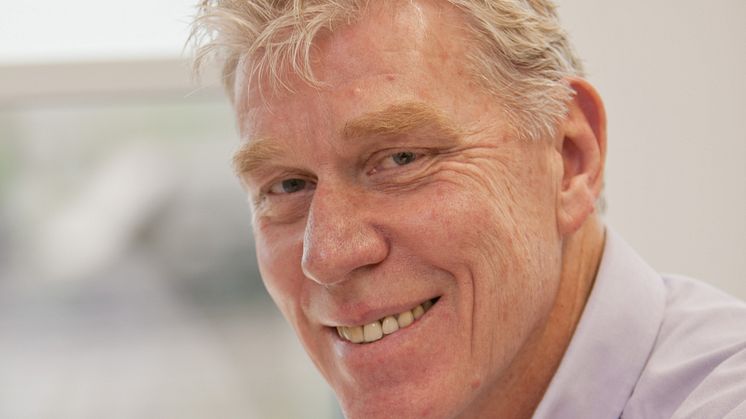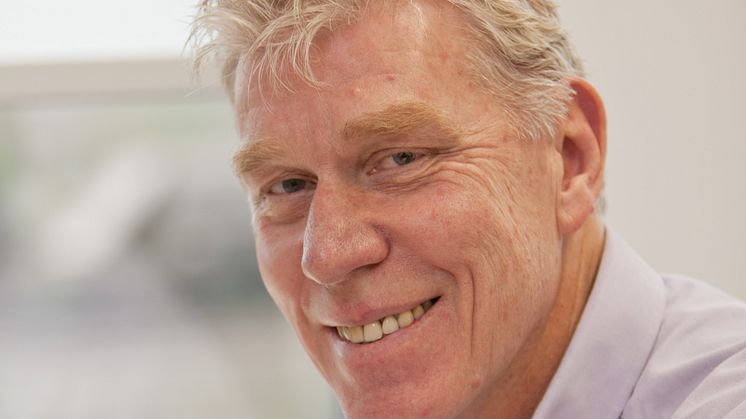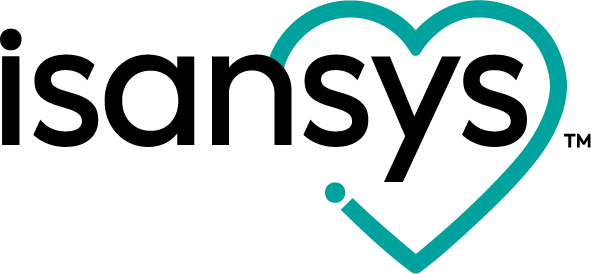
Blog post -
Spotlight on: Keith Errey, CEO of Isansys Lifecare Ltd
In 2010, the cofounders of Isansys Lifecare Ltd, Keith Errey and Rebecca Weir, set out with a vision to overcome barriers of technology integration and data accessibility in healthcare. They wanted to provide healthcare organisations with patient monitoring technologies and data analytics that would improve clinical decision making and patient outcomes, and reduce the costs of dealing with patient safety issues such as avoidable death and adverse events.
Over the course of the last five years, Isansys has made that vision a reality by creating a wireless patient monitoring system, called the Patient Status Engine (PSE). This provides a complete end-to-end platform to continuously and wirelessly capture, collect, interpret and securely store vital sign and other physiological data. The PSE incorporates a range of unobtrusive wearable sensors including the Lifetouch cardiac monitor, a wireless ‘smart patch’ that collects data directly from the patient and analyses every heartbeat to provide continuous heart rate, respiration rate and heart rate variability; the Lifetemp, a continuous wireless clinical thermometer, a continuous wireless pulse oximeter and a wireless blood pressure monitor.
Now the Oxfordshire-based company is launching the PSE2, its second generation wireless patient digitisation platform which incorporates the accumulated learning and feedback from hundreds of doctors, nurses and patients, and will significantly improve patient monitoring and provide robust data and timely early warning indicators in hospital and at home.
Here Keith Errey tells us about how the PSE2 will meet the demands of the clinicians, and enable healthcare providers to better address those crucial patient safety issues that were the starting point of the Isansys journey: to reduce the number of avoidable deaths and adverse events in hospital, reduce lengths of stay, and enable new pathways to keep patients out of hospital in the first place.
Tell us about Isansys…
Isansys is a company which has developed a complete, end-to-end wireless patient monitoring and analysis platform for hospitals and health organisations globally.
We started out with the idea of being able to take data from patients continuously and in a way which was inobtrusive. That meant we had to develop a suite of wireless technologies which can be worn on the body and collect vital sign data continuously and in real time.
With this system, patients are continuously monitored, almost like intensive care grade monitoring, but in any, or every bed in hospital and also at home.
What this is really doing is ‘digitising’ the patient. We are taking the patients vital signs and immediately turning them into digital information. These rich data sets are then used as inputs for analytical models that support clinical decision making by providing new kinds of predicitve and diagnostic information.
What are the challenges facing the healthcare industry and how does the Patient Status Engine address the healthcare needs of today?
Ensuring the safety of everyone that comes into contact with healthcare services is one of the most important challenges facing healthcare providers today.
Patients and their families should feel that a hospital is a place of care and comfort, somewhere they would be looked after. Instead they are now often seen as places fraught with risk of patient harm.
It is now widely accepted that 1 in 10 patients admitted to hospital will be unintentionally harmed in some way[1] [2]. To put that into context in the extreme case for the UK: there are more deaths annually as a result of health care than from road accidents, breast cancer and AIDS combined. Some of these deaths will be inevitable complications of treatment, however at least half of them are thought to be preventable.
Although the 10% figure of harm happening to admitted patients is well known, this level of error is completely unacceptable in many other industries (eg aviation) so when it comes to the healthcare industry, zero harm should be the target.
In the UK, reviews of case records have shown that last year there were 1.2 million reported care incidents[3], and in 2012/ 2013, there were 850,000 reported adverse events[4]. These figures are not indicative of particular failings of the NHS but are reflected in similar records around the world. In 2012, deaths from potentially avoidable causes accounted for approximately 23% of all deaths registered in hospitals in England and Wales[5]. While medical errors have not been as extensively studied in outpatient settings, it is estimated that as many as 35% of outpatients experience an adverse drug event[6] [7] [8] [9] [10] and that 13% of all adverse events identified during hospitalisations occur during outpatient care[11] [12].
Recent financial estimates also suggest that adverse events cost the UK £2.5 billion in 2012/2013 in extra hospital days alone and £1.2 billion in clinical negligence costs. Other costs, such as the suffering of patients, their families and the health care workers involved, are incalculable[13]. In fact, the total costs of patient safety in the NHS are around £5 billion annually. This is an incredible amount and is essentially wasteful and unnecessary spending. Interestingly, this offers the intriguing but very real prospect of safer care being lower cost care.
It is clear then that dealing with the effects of patient safety related issues is a very expensive diversion of healthcare funds. In addition to the ensuing distress for patients, families and frontline staff and the greater bureaucratic burden for management, the financial implications add enormously to the pressures on the NHS, limiting its ability both to treat more patients and to provide higher quality services.
How does the PSE work and why is it important?
The Patient Status Engine (PSE) integrates a range of advanced medically certified wireless wearable vital sign sensors, developed by Isansys, with secure networking technologies and predictive analytics. The network architecture is open and allows other third party sensors and devices to be integrated into a clinically validated platform.
The PSE enables a complete end-to-end service to continuously and wirelessly capture, collect, interpret and securely store vital sign and other physiological data. Inherent in the digital nature of the PSE platorm is the ability to monitor and analyse subtle variations in vital signs that are early warning signs of many serious conditions, for example sepsis – a life-threatening whole-body infection.
This data collected by the PSE not only enhances the relationship between the patient and the physician, but is presented in such a way to ensure that the patient information in the database can then be securely transferred to any existing hospital information system and/or delivered to any authorised user – anytime, anywhere.
Can you explain what the Lifetouch is?
The Lifetouch is a new kind of medical device. It’s something which looks to be a simple piece of equipment actually it’s very subtle and technically very sophisticated. We have a design philosophy of making things look really simple and hiding the high-tech nature of them. For that reason, it feels comfortable for nursing staff to use and for patients to wear as well.
The Lifetouch is a ‘smart patch’ technology. It’s presented like a sticking plaster which is placed across the chest and it sticks to the chest with standard ECG electrodes.
When connected to the patient it analyses the ECG signal at high resoltion (1000 samples per second) to provide heart rate, respiration rate and real time R-R intervals for heart rate variability (HRV) methods. It may also be remotely triggered to show a real time ECG trace. All the data is uploaded and held in a secure data base or forwarded via an open API to an exisitng electronic patient record.
How can this data be used?
This data can be used in two ways. Firstly, the data is used to give the clinical and nursing teams a way of knowing what’s happening to the patient at that moment. In a way it’s exactly the same as a nurse coming round and taking observations, measuring blood pressure, heart rate, oxygen saturation levels and writing them down. However, instead of writing them down, the system automatically collects the data and immediately puts it into a data store. It then displays this by the bedside. So, instead of having charts beside the bedside, where every four hours data is put on the chart, this system draws the chart in real time. The nurses and doctors who then visit the patient can see exactly what’s happened to the patient at any point in time.
Secondly, and more interestingly, we are collecting data to use in a range of diagnostic and predicitve algorithms that we and our clinical partners are developing. With this data it is then possible to determine the trajectory of a patient simply, unobtrusively and remotely.
In a very real sense, this is allowing the care team to be able to look into the future of the patient. This enables them to act in a timely manner to any indicators of early warning signs and take action to prevent something far worse happening.
What added benefits over manual patient observation does it deliver?
The Patient Status Engine can change a patient’s experience in hospital enormously because the very first thing the patient will notice is there are no cables, no leads and no wires connecting them to a bedside monitoring unit. That means that although the patient is under close surveillance they will feel free and unfettered. They can sit up, get up, walk around, go to the toilet or visitors room then come back again while remaining monitored at all times.
The system is very smart so when you walk out of range or leave the room and are unable to connect to the gateway unit directly, the wearable devices will hold onto the data but still carry on analysing the patient’s heartbeat. When they go back near the unit, it downloads the information and no data is lost.
What are the additional benefits of the PSE?
Through the acquisition of continuous real time phyiological and other biomarker data sets from individual patients in either a hospital or home settings, large data sets are built up providing reliable and highly relevant data for immediate or subsequent analysis. The clinicians and nurses can then use these predictive algorithms as new tools to see what is happening to their patient and how their treatment can be altered or adjusted accordingly.
For the first time ever, the idea of real patient-centred care becomes possible because we can measure the patients’ physiological “image” and their responses to treatment in real time. No matter where patients are located, whether in hospital or at home, their current status including their responses to treatment will immediately be visible to their care team. In addition, through the power of data driven healthcare and predictive algorithms their future status is also able to be presented. This not only provides a new way to measure patient outcomes, but also gives clinicians a new set of quantifieable measures to optimise patient care.
What patient/clinical needs/areas will it target?
The PSE is an unusual medical device in that it is not targeting one specific condition. The PSE is a general purpose platform “instrument” that provides the basic data and information that doctors and nurses have always used to care for their patients. It can be used for general in-hospital monitoring for early warning scores or for providing early warning indicators of deterioration in at-risk patients at home.
Will it confer any cost savings to a healthcare system?
We have developed this system to be as low cost as it can possibly be. This isn’t because we’re trying to save money. It’s because what we’re doing here is using available technology and repurposing it to be used in a healthcare setting. The cost of these systems is already much less than equivalent systems in hospital at the present time. In fact, as a next generation system it’s about 1/10th the cost of existing patient monitoring equipment of equivalent functionality but inherently digital and connected, offering dashboards and remote viewing of patient data as standard.
The economic impact of the Isansys platform is difficult to estimate but has the potential to be very significant. Of the estimated £5 billion costs to the NHS associated with patient safety, the adoption of the Patient Status Engine as standard care could potentially reduce this amount by 30% or more. The cost of widespread adoption (“every patient monitored”) of the PSE is around £1 billion, leading to an annual net saving of £0.5 to £1 billion.
How many hospitals or trusts is it being used in at the moment? What has been the feedback?
The first-generation PSE has been used in several UK hospitals and in two major hospital groups in India. Each of these are doing something different in terms of patient grouping and the outcomes from the work being undertaken. The feedback from the doctors, nurses and patients using the PSE has enabled us to develop a second-generation system and has led to at-scale deployments which are the first steps toward new standard care pathways using the PSE and hospital-wide deployments. Learning from the first-generation product has also led to a reconfiguration of the systems to address a number of new opportunities to provide higher acuity out-of-hospital care.
How will the technology be developed further with the aid of the second phase of funding from SBRI?
Following the news of our success securing a £1 million Phase 2 contract with the Small Business Research Initiative (SBRI Healthcare), Isansys is now increasing the functionality and extending the intended use of the PSE. This will not only meet the demands of healthcare providers for innovative, market-ready solutions, that can enable improved patient monitoring and alerting both in hospitals and at home, but it will also address crucial patient safety issues.
The second phase of SBRI funding is leading to the development of a new generation of body worn wireless sensing devices which in turn lead to more accurate and complete datasets from which better diagnostic and predictive algorithms are being developed.
Our on-going development programme will also enable the costs of monitoring patients to be further reduced to the point where it becomes possible for every in-patient to be monitored safely, securely and automatically.
How have the last five years been for Isansys?
Over the years, my cofounder Rebecca Weir and I have listened to providers and clinicians needs and created a precision monitoring platform which will not only continuously monitor their patients but collect highly relevant data that can be used for immediate or subsequent analysis. To create new devices and a complete intelligent platform that can collect such valuable and useable data, is CE marked, and is starting to be used as standard care in just five years is a great achievement. Sometimes it seems like it has taken a long time but this is a necessary journey and rightly, any new technology or method intended for clinical use must show evidence of new benefits both clinically and economically, and this takes time.
Isansys isn’t just a technology company and we’re not just making medical devices here. We’re creating a platform and a service model which will change the face of healthcare as we see it, and, the exciting thing is, the more work we do on this, the more we recognise how important and profound this new data driven approach to healthcare is.
[1] http://www.who.int/patientsafety/journals_library/Improving_Patient_Safety.pdf, p4
[2] http://www.health.org.uk/public/cms/75/76/313/2593/Levels%20of%20harm.pdf?realName=PYiXMz.pdf, p4
[3][3] http://m.hsj.co.uk/5081758.article
[4] http://proqualis.net/sites/proqualis.net/files/5_getting-started-at-the-national-level-from-demonstration-to-spread.pdf
[5] http://www.ons.gov.uk/ons/rel/subnational-health4/avoidable-mortality-in-england-and-wales/2012/stb-avoidable-mortality--2012.html
[6] http://www.j-biomed-inform.com/article/S1532-0464(03)00068-6/fulltext
[7] Hutchinson, T.A., Flegel, K.M., Kramer, M.S., Leduc, D.G., and Kong, H.H.Frequency, severity and risk factors for adverse drug reactions in adult out-patients: a prospective study.J. Chronic Dis.1986;39:533–54
[8] Hanlon, J.T., Schmader, K.E., Koronkowski, M.J. et al.Adverse drug events in high risk older outpatients.J. Am. Geriatr. Soc.1997;45:945–948
[9] Gandhi, T.K., Burstin, H.R., Cook, E.F. et al.Drug complications in outpatients.J. Gen. Intern. Med.2000;15:149–154
[10] Honigman, B., Lee, J., Rothschild, J. et al.Using computerized data to identify adverse drug events in outpatients.J. Am. Med. Inf. Assoc.2001;8:254–266
[11] http://www.j-biomed-inform.com/article/S1532-0464(03)00068-6/fulltext
[12] Brennan, T.A., Leape, L.L., Laird, N.M. et al.Incidence of adverse events and negligence in hospitalized patients. Results of the Harvard Medical Practice Study I.N. Engl. J. Med.1991;324:370–376
[13] http://www.nhsla.com/aboutus/Documents/NHS%20LA%20Annual%20Report%20and%20Accounts%202013-14.pdf




